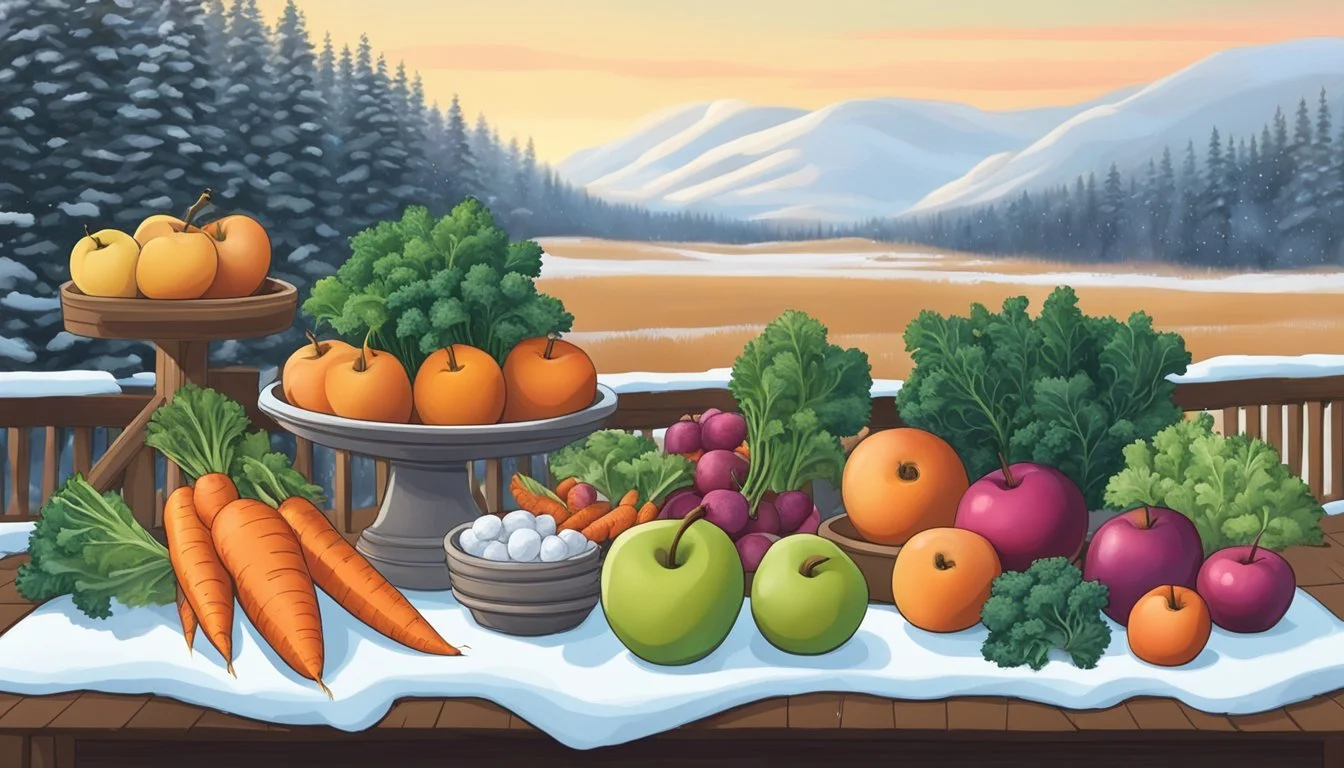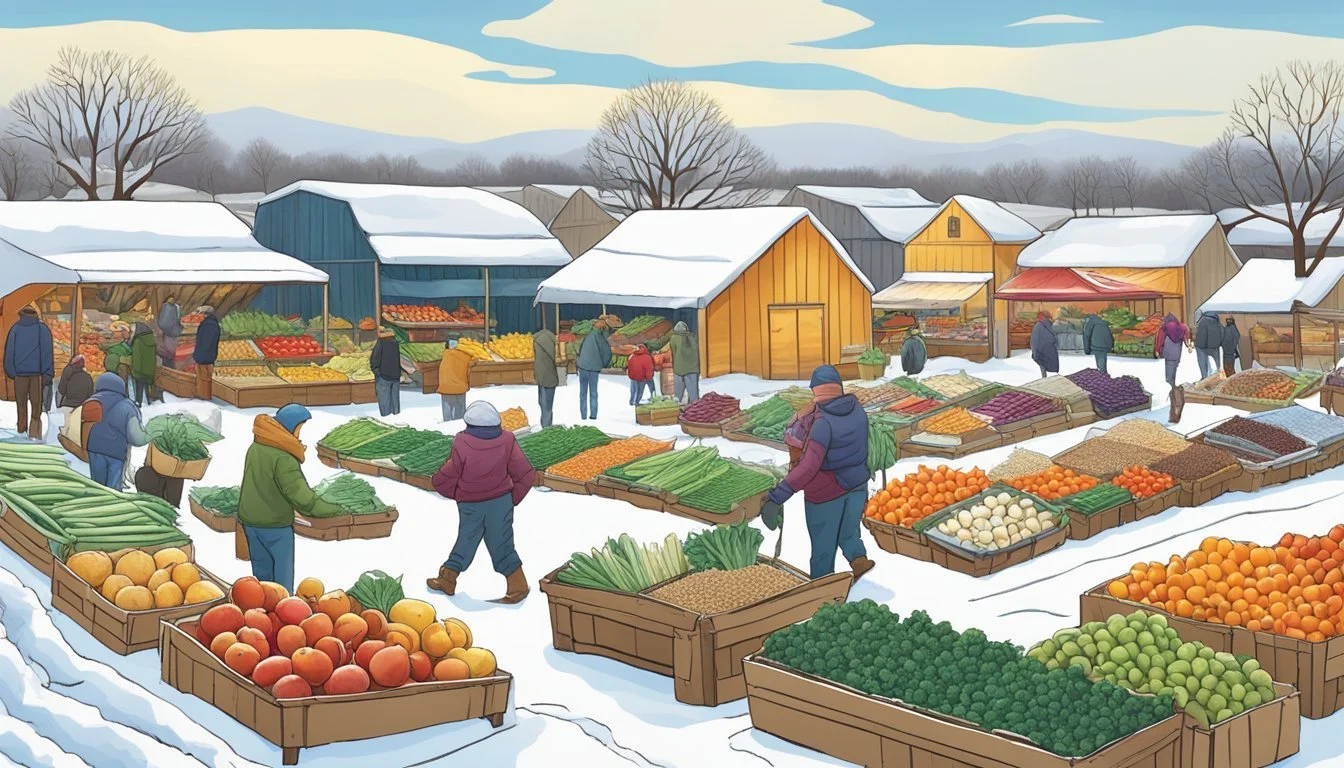Minnesota Seasonal Fruit & Vegetables in January
A Guide to Eating Fresh and Local
This Article is Part of our Minnesota Seasonal Fruit & Veg Calendar
Minnesota's climate presents unique challenges for cultivators and consumers of fresh produce. January, in particular, is a time when the state is enveloped in cold temperatures and snow, affecting what fruits and vegetables are available locally. However, despite these climatic constraints, Minnesotans still enjoy access to a variety of seasonal produce during the winter months, largely thanks to modern storage techniques and winter-hardy crops.
Among the fresh produce available, root vegetables like carrots (how long do carrots last?), parsnips, and beets maintain their quality well into the winter when stored properly. These robust vegetables are often harvested in the fall and can be kept in cool, dark conditions where they remain crisp and flavorful. Locally stored apples (how long do apples last?) also tend to be accessible during this period, offering sweet and tart options for consumers.
Greenhouses and indoor farming are gaining traction in Minnesota as well, providing leafy greens and herbs throughout January. While the selection of locally-grown fruits and vegetables is limited during this time compared to the bountiful summer months, these indoor cultivation methods are an innovative response to the demand for fresh produce year-round.
Overview of Minnesota's Seasonal Produce
January presents characteristic challenges for agriculture in Minnesota due to its climate. This section offers insights into how these conditions affect local produce and pinpoints when certain crops become available throughout the year.
Understanding the Climate and its Impact on Produce
Weather: Minnesota experiences harsh winters, with temperatures frequently dropping below freezing. The cold climate limits crop availability, confining fresh produce to those that are cold-tolerant or stored from previous harvests.
Winter: During winter months, few crops are harvested outdoors. However, some farms use controlled environments like greenhouses to grow certain types of produce.
Key Harvest Times for Locally Grown Produce
Harvested: Through winter, Minnesota relies heavily on produce harvested in the preceding months and stored for off-season use.
Crop Availability:
Stored Harvest: Items like potatoes, carrots, and onions are typically stored from the fall harvest and remain available.
Greenhouse Crops: Some greens and herbs may be cultivated in greenhouses and are thus accessible despite the weather.
The prime harvest times for fresh, field-grown produce lie outside of January, with peak seasons usually occurring from late spring through fall.
Fruits Available in January
January in Minnesota offers a limited but flavorful selection of fruits that can endure the cold winter climate. Citrus fruits, in particular, stand out during this season. Their availability peaks owing to their growth in warmer climates, where they are harvested during the winter months and then shipped to colder regions.
Grapefruit: Known for its tangy yet semi-sweet flavor, grapefruit is a versatile fruit that is readily available during January. It can be enjoyed on its own, in salads, or as a juice.
Lemon: Essential in both sweet and savory dishes, lemon adds a zest that enhances the dish's overall flavor. Whether used for its juice, zest, or as a garnish, its tangy flavor is a kitchen staple even in the cold season.
Orange: A classic winter fruit, oranges are not only delicious but also packed with vitamin C, which is especially welcome during the winter months. They can be found in various forms, from navel to blood oranges, each offering a distinct taste and level of sweetness.
Lime: Often used to add a bright punch to beverages and foods, limes contribute a distinct sharpness that complements a variety of dishes.
While the variety of seasonal produce in Minnesota during January may be more restricted than in the bountiful summer months, these citrus fruits provide a refreshing burst of flavor and nutrients that are highly valued during the winter. They also carry the essence of the warmer territories into Minnesota homes, offering both taste and comfort in the heart of winter.
Vegetables to Enjoy During Minnesota's Winter
While winter in Minnesota may blanket the landscape in snow, it doesn't halt the availability of fresh, in-season vegetables. Root vegetables and hearty greens thrive in this frosty climate and can be found in abundance.
Root Vegetables: Root vegetables are the stars of the Minnesota winter season. These hardy staples store well and provide a wealth of nutrients:
Carrots maintain their sweetness and crunchy texture, making them perfect for stews, soups, and as a healthy snack.
Potatoes also feature prominently. Their versatility allows them to be a part of many dishes, lending their comforting richness.
Beets come in various colors and are packed with antioxidants. They're great when roasted or boiled.
Celery root, also known as celeriac, offers a subtle, celery-like flavor that pairs well with other winter vegetables.
Turnips can be mashed or roasted, providing a pleasantly pungent and slightly bitter taste.
Hearty Greens: In addition to root vegetables, some greens brave the cold:
Kale is abundant and can withstand chilly temperatures. This nutrient-dense green offers vitamins A, C, and K, among others.
Likewise, collard greens (how long do collard greens last?) remain available, bringing nutritional variety to winter meals.
Squash: Squash varieties are another key feature in the local winter produce scene. Their rich, sweet flesh can be enjoyed in everything from baked goods to creamy soups.
Availability of winter vegetables can vary, but local farmers' markets and some supermarkets stock up on these seasonal gems. They provide fresh options and add a comforting element to meals during the colder months, fostering the enjoyment of local, seasonal produce.
Preparation and Recipe Ideas
In the heart of winter, Minnesotans embrace the bounty of January produce with hearty recipes and proper storage techniques to maximize flavor and freshness.
Creating Seasonal Meals with January Produce
In Minnesota, January brings a variety of root vegetables that can be transformed into comforting meals. A roasted root vegetable medley featuring carrots, turnips, and parsnips drizzled with olive oil becomes a flavorful side dish when seasoned with garlic and herbs. These vegetables can also be the backbone of a nourishing stew, simmered slowly to develop a deep, rich taste that warms during the colder days.
One must not overlook the versatility of squash. Ripe butternut squash (how long does butternut squash last?) can be cut into fries and baked as a healthier alternative to traditional potato fries. Additionally, incorporating squash into soups adds a sweet, nutty flavor and a creamy texture without the need for heavy creams.
Recipe Suggestion:
Hearty Root Vegetable Stew:
Peel and chop an assortment of root vegetables.
Brown your choice of meat, if desired, in a large pot.
Add the vegetables and cover with stock or water.
Season with salt, pepper, and thyme.
Simmer until the ingredients are tender.
Storage Tips for Fresh Produce
Proper storage is essential to maintain the freshness of January produce. Root vegetables should be stored in a cool, dark place, ideally in a cellar or a ventilated pantry. They tend to last longer when kept in a humid environment, so consider storing them in perforated plastic bags to retain moisture.
For items like apples and pears, refrigeration can help prolong their shelf life. Store them in the crisper drawer to keep them crisp and juicy. If refrigeration space is limited, a garage or enclosed porch, as long as the area remains just above freezing, can act as an impromptu cold storage for these fruits.
Storage Quick Reference:
Root Vegetables:
Store in a cool, dark, humid place.
Place in perforated plastic bags.
Apples and Pears:
Refrigerate in the crisper drawer.
Alternative: Store in a cool garage or porch above freezing.
Local Farming and Markets
In the heart of winter, Minnesota's local farming operations continue to support communities with seasonal offerings. Despite January's challenging cold, farmers and markets play a crucial role in food distribution. They often shift focus to storage crops and greenhouse-grown produce.
Farmers in Minnesota adapt to the cold by concentrating on crops that can be stored throughout the winter or those that can be cultivated in controlled environments. Root vegetables like carrots, turnips, and beets, along with winter squash and apples, are common storage crops available at local markets.
Local markets, such as Untiedt's Vegetable Farm, adjust operations during the winter months. While some markets remain open year-round, the offerings lean towards the hardier, storage-friendly items:
Root Vegetables: Potatoes, onions, etc.
Apples
Several markets, including roadside farm stands and farmers' markets, set up indoors or modify hours to maintain accessibility to local food for consumers. Consumers can still enjoy a variety of fresh, sustainably grown produce from these markets, even during the coldest months.
While outdoor market spaces often see reduced activity, they establish a foundation for the local food economy. They not only sell produce but also provide vital support to Minnesota's local farmers by sustaining a network of food distribution and maintaining a connection between consumers and their food's origin.
Month-by-Month Guide to Harvesting
Understanding the seasonality of produce ensures freshness and supports local growers. While the cold climate of Minnesota limits the availability of fresh produce in February, root vegetables and those stored from fall harvests usually remain accessible.
What to Expect in February and Beyond
In February, Minnesotans typically rely on vegetables that store well through the cold winter months. Options may include:
Root Vegetables: Carrots, potatoes, and beets from cold storage are often accessible.
Winter Squash: Varieties such as butternut or acorn squash are common.
Seasonal Produce: While many fields lie dormant, some growers utilize greenhouses to provide limited quantities of produce like leafy greens.
As they move beyond February, residents can anticipate a transition in available produce. Late winter to early spring marks the end of the storage crop season, and the gradual beginning of the spring harvest. In the coming months, they can expect:
Early Greens: As the ground thaws, spinach and kale may become available from greenhouses or fields.
Spring Vegetables: Radishes and peas often make an appearance as the season progresses.
This guide emphasizes the importance of adjusting expectations based on the season, especially in a climate as variable as Minnesota's.







